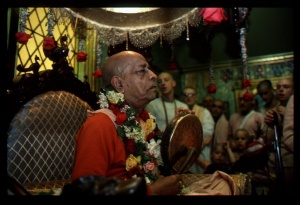CC Adi 7.42 (1975): Difference between revisions
(Vanibot #0027: CCMirror - Mirror CC's 1996 edition to form a basis for 1975) |
(Vanibot #0020: VersionCompareLinker - added a link to the Version Compare feature) |
||
| Line 2: | Line 2: | ||
<div style="float:left">'''[[Sri Caitanya-caritamrta (1975)|Śrī Caitanya-caritāmṛta (1975)]] - [[CC Adi (1975)|Ādi-līlā]] - [[CC Adi 7 (1975)|Chapter 7: Lord Caitanya in Five Features]]'''</div> | <div style="float:left">'''[[Sri Caitanya-caritamrta (1975)|Śrī Caitanya-caritāmṛta (1975)]] - [[CC Adi (1975)|Ādi-līlā]] - [[CC Adi 7 (1975)|Chapter 7: Lord Caitanya in Five Features]]'''</div> | ||
<div style="float:right">[[File:Go-previous.png|link=CC Adi 7.41 (1975)|Ādi-līlā 7.41]] '''[[CC Adi 7.41 (1975)|Ādi-līlā 7.41]] - [[CC Adi 7.43 (1975)|Ādi-līlā 7.43]]''' [[File:Go-next.png|link=CC Adi 7.43 (1975)|Ādi-līlā 7.43]]</div> | <div style="float:right">[[File:Go-previous.png|link=CC Adi 7.41 (1975)|Ādi-līlā 7.41]] '''[[CC Adi 7.41 (1975)|Ādi-līlā 7.41]] - [[CC Adi 7.43 (1975)|Ādi-līlā 7.43]]''' [[File:Go-next.png|link=CC Adi 7.43 (1975)|Ādi-līlā 7.43]]</div> | ||
{{CompareVersions|CC|Adi 7.42|CC 1975|CC 1996}} | |||
{{RandomImage}} | {{RandomImage}} | ||
==== TEXT 42 ==== | ==== TEXT 42 ==== | ||
| Line 25: | Line 24: | ||
<div class="translation"> | <div class="translation"> | ||
"This Caitanya Mahāprabhu is an illiterate sannyāsī and therefore does not know His real function. Guided only by His sentiments, He wanders about in the company of other sentimentalists." | |||
</div> | </div> | ||
| Line 32: | Line 31: | ||
<div class="purport"> | <div class="purport"> | ||
Foolish Māyāvādīs, not knowing that the Kṛṣṇa consciousness movement is based on a solid philosophy of transcendental science, superficially conclude that those who dance and chant do not have philosophical knowledge. Those who are Kṛṣṇa conscious actually have full knowledge of the essence of Vedānta philosophy, for they study the real commentary on the Vedānta philosophy, Śrīmad-Bhāgavatam, and follow the actual words of the Supreme Personality of Godhead as found in Bhagavad-gītā As It Is. After understanding the Bhāgavata philosophy, or bhāgavata-dharma, they become fully spiritually conscious or Kṛṣṇa conscious, and therefore their chanting and dancing is not material but is on the spiritual platform. Although everyone admires the ecstatic chanting and dancing of the devotees, who are therefore popularly known as | Foolish Māyāvādīs, not knowing that the Kṛṣṇa consciousness movement is based on a solid philosophy of transcendental science, superficially conclude that those who dance and chant do not have philosophical knowledge. Those who are Kṛṣṇa conscious actually have full knowledge of the essence of Vedānta philosophy, for they study the real commentary on the Vedānta philosophy, Śrīmad-Bhāgavatam, and follow the actual words of the Supreme Personality of Godhead as found in Bhagavad-gītā As It Is. After understanding the Bhāgavata philosophy, or bhāgavata-dharma, they become fully spiritually conscious or Kṛṣṇa conscious, and therefore their chanting and dancing is not material but is on the spiritual platform. Although everyone admires the ecstatic chanting and dancing of the devotees, who are therefore popularly known as "the Hare Kṛṣṇa people," Māyāvādīs cannot appreciate these activities because of their poor fund of knowledge. | ||
</div> | </div> | ||
Latest revision as of 19:27, 26 January 2020

A.C. Bhaktivedanta Swami Prabhupada
TEXT 42
- mūrkha sannyāsī nija-dharma nāhi jane
- bhāvuka ha-iyā phere bhāvukera sane
SYNONYMS
mūrkha—illiterate; sannyāsī—one in the renounced order of life; nija-dharma—own duty; nāhi—does not; jāne—know; bhāvuka—in ecstasy; ha-iyā—becoming; phere—wanders; bhāvukera—with another ecstatic person; sane—with.
TRANSLATION
"This Caitanya Mahāprabhu is an illiterate sannyāsī and therefore does not know His real function. Guided only by His sentiments, He wanders about in the company of other sentimentalists."
PURPORT
Foolish Māyāvādīs, not knowing that the Kṛṣṇa consciousness movement is based on a solid philosophy of transcendental science, superficially conclude that those who dance and chant do not have philosophical knowledge. Those who are Kṛṣṇa conscious actually have full knowledge of the essence of Vedānta philosophy, for they study the real commentary on the Vedānta philosophy, Śrīmad-Bhāgavatam, and follow the actual words of the Supreme Personality of Godhead as found in Bhagavad-gītā As It Is. After understanding the Bhāgavata philosophy, or bhāgavata-dharma, they become fully spiritually conscious or Kṛṣṇa conscious, and therefore their chanting and dancing is not material but is on the spiritual platform. Although everyone admires the ecstatic chanting and dancing of the devotees, who are therefore popularly known as "the Hare Kṛṣṇa people," Māyāvādīs cannot appreciate these activities because of their poor fund of knowledge.